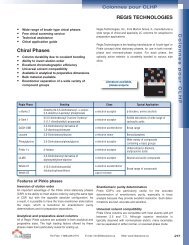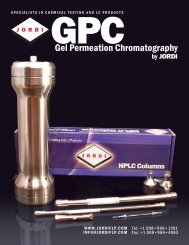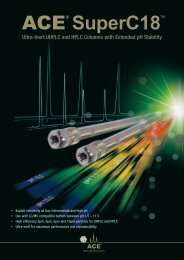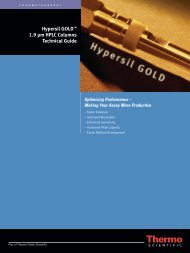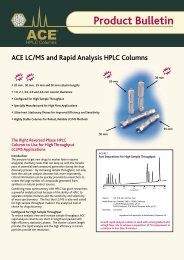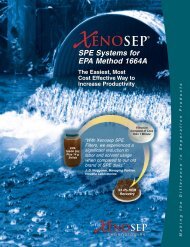Fused-Core⢠Particles for Very Fast HPLC Separations
Fused-Core⢠Particles for Very Fast HPLC Separations
Fused-Core⢠Particles for Very Fast HPLC Separations
Create successful ePaper yourself
Turn your PDF publications into a flip-book with our unique Google optimized e-Paper software.
An Example of Converting a Conventional<br />
Separation to an Ultra-<strong>Fast</strong> Separation.<br />
Conventional <strong>HPLC</strong> Separation Conditions<br />
COLUMN: 4.6 x 250 mm, 5 μm<br />
FLOW RATE: 1.5 ml/min<br />
MOBILE PHASE: Isocratic<br />
RUN TIME: 10 minutes<br />
PRESSURE: 1,580 psi, 109 bar<br />
Maximum acceptable pressure = 4,000 psi, 275 bar<br />
RESOLUTION: 3.0<br />
SAMPLE INJECTION VOLUME: 20 μl<br />
Converting to Ultra-<strong>Fast</strong> Separation Conditions<br />
1. Select the shortest ultra-fast column that provides resolution<br />
equivalent to or better than the conventional column. (See Relative<br />
Resolution chart in Figure A.)<br />
A column 4.6 x 100 mm packed with 1.7 μm particles is selected<br />
<strong>for</strong> further investigation.<br />
2. Estimate back pressure. (See relative pressure table in Figure B.)<br />
8.7 100 mm<br />
P Ultra-<strong>Fast</strong> Column<br />
= 1,580 psi x x = 5,498 psi<br />
1 250 mm<br />
Since this ultra-fast column exceeds our maximum acceptable<br />
back pressure (4,000 psi), a different ultra-fast column is selected<br />
<strong>for</strong> investigation.<br />
The alternative ultra-fast column selected is a 4.6 x 100 mm packed<br />
with 2.7 μm <strong>Fused</strong>-Core particles (HALO <strong>HPLC</strong> column). The<br />
back pressure on this column is:<br />
3.4 100 mm<br />
P Ultra-<strong>Fast</strong> Column<br />
= 1,580 psi x x = 2,149 psi<br />
1 250 mm<br />
This ultra-fast column provides both acceptable resolution and<br />
acceptable back pressure <strong>for</strong> our method.<br />
3. Confirm that the selectivity and resolution of the ultra-fast column<br />
is adequate.<br />
For simplicity, we will assume that the selectivity of this ultra-fast<br />
column is almost identical to the selectivity of the conventional<br />
column and, there<strong>for</strong>e, the resolution is adequate.<br />
4. Optimize flow rate to minimize run time. (See Figure C to estimate<br />
changes in resolution with changes in flow rate.)<br />
We can further reduce run time by operating the ultra-fast<br />
column at a higher flow rate. We just have to make sure we stay<br />
within the requirements of minimum resolution and maximum<br />
pressure. The ultra-fast column we selected has low enough back<br />
pressure that we can operate at a flow rate of 2.5 ml/min and still<br />
stay within our defined limits of pressure and resolution.<br />
P at 2.5 ml/min<br />
= 2,149 psi x<br />
5. Adjust the gradient time.<br />
This is an isocratic separation, so no adjustment to gradient time<br />
is required.<br />
6. Adjust the injection volume. (See Figure D <strong>for</strong> calculations and table<br />
with estimated column volumes.)<br />
Sample volume =20 μl x<br />
Ultra-<strong>Fast</strong> Conditions<br />
2.5 ml/min<br />
1.5 ml/min<br />
0.84 ml<br />
2.62 ml<br />
= 3,582 psi<br />
= 6.4μl<br />
COLUMN: 4.6 x 100 mm, 2.7 μm <strong>Fused</strong>-Core (HALO®)<br />
FLOW RATE: 2.5 ml/min<br />
RUN TIME: 0.84 ml 1.5 ml/min<br />
10 min x x = 1.9 min*<br />
2.62 ml 2.5 ml/min<br />
RESOLUTION: 3.1<br />
PRESSURE: 3,582 psi<br />
SAMPLE INJECTION VOLUME: 6.4 μl<br />
* Run time <strong>for</strong> the ultra-fast separation can be estimated by multiplying the run time on the conventional column by the<br />
ratio of the volumes of ultra-fast column to the conventional column and then by the inverse ratio of the flow rates on<br />
the two columns. (See page 12)<br />
— 8 —<br />
— 9 —



